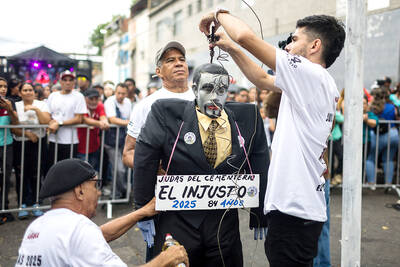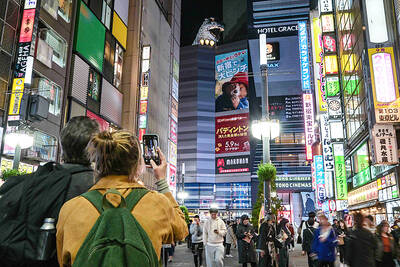Rich or poor, liberal or conservative, from one corner of the globe to another, everyone sits down to share a meal.
Thai artist Rirkrit Tiravanija is betting that this communal experience can break down artificial divides as he serves curry to visitors at Washington’s Hirshhorn Museum and Sculpture Garden in an installation that opened on Friday.
The feast is part of the art. Visitors fill their bellies with red, yellow and green curries while watching local artists cover the once white gallery walls with photo-realistic drawings of protests in Thailand and the US.

Photo: AFP
“There are people who would have never sat next to each other sitting next to each other, discovering each other or themselves in a different way,” Tiravanija told reporters.
In a 2010 presentation in Bangkok, Tiravanija did the cooking himself with open fires and boiling pots of curry alongside fresh ingredients — an impossible task in security-minded US museums.
At the Hirshhorn, local restaurant Beau Thai is catering the food.
“It’s not every day that we have heating elements — otherwise known as fire to our fire wardens — and food,” museum director Melissa Chiu said jokingly.
Even when the daily servings of curry are gone, the spiced fragrances linger, and the installation encourages people to meet, gather and discuss in a joyous cacophony enhanced by the steel flooring in the 150-person capacity room.
Tiravanija, who had participants make friends while washing dishes at the posh Art Basel fair in 2015, is part of a group of artists including Pierre Huyghe, Liam Gillick and Jorge Pardo concerned with “relational aesthetics,” whose works are defined by the interaction and collaboration they elicit.
“It’s experiential, it’s about art that socializes ideas and sets open discussion spaces,” curator Mark Beasley said.
The title of the installation, (who’s afraid of red, yellow and green), is a wink to US artist Barnett Newman’s provocative Who’s Afraid of Red, Yellow and Blue series of four large-scale paintings, two of which were vandalized in museums.
Tiravanija’s use of parentheses and lowercase suggests the questions here are more of a “subtext.”
The colors in the title of Tiravanija’s piece represent the military (green) and the two main factions of anti-government protesters in Thailand at their peak in 2010: the Red Shirt rural farmers and Yellow Shirt royalists.
“For me, it’s the irony of the idea of the color,” Tiravanija said. “I wanted to show that may be this color or that color, but you still eat the same curries, you still live in the same place.”
Societies have become more sophisticated and technologically advanced, but, the work recalls, a primal tendency to destroy one another remains.
“We should have a better world now,” Tiravanija said. “The terrible thing about it is that it keeps cycling back — violence or the fear of the other — and it’s being used. It’s not just inane, it’s manipulation.”
Breaking down barriers over a meal might sound utopian, but the murals serve as a reminder of societal frictions that lie just beneath the surface.
They include reproductions of photographs taken from the 2010 Thai political protests and crackdown, the US civil rights movement, the Women’s March in Washington and the 1976 Thammasat University massacre, when Thai state forces and paramilitary groups killed dozens of students.
The sketches are to be drawn on top of one another in thick layers.
“It will get dense enough that it will cancel itself out, but in that sense, I would like to say: ‘Don’t forget that it is still there,’” Tiravanija said. “With machines that remember everything for us, we are going to lose our memory much faster than we realize.”
The ephemeral experience, which the Hirshhorn has added to its collection and runs through July 24, is participatory, so museumgoers are encouraged to lend their hand to the mural.
To supplement the experience, six films by emerging Thai filmmakers curated by independent director and Palme d’Or winner Apichatpong Weerasethakul are screened in one room, with Tiravanija’s 2011 feature Lung Neaw Visits His Neighbors in another.
The latter film follows a retired Thai rice farmer living off the land in the bucolic surroundings of his native northern Chiang Mai Province at a time when the capital, Bangkok, was erupting with political unrest.
It begs the question: In such paradisiacal surroundings, what else is needed?

POLITICAL PRISONERS VS DEPORTEES: Venezuela’s prosecutor’s office slammed the call by El Salvador’s leader, accusing him of crimes against humanity Salvadoran President Nayib Bukele on Sunday proposed carrying out a prisoner swap with Venezuela, suggesting he would exchange Venezuelan deportees from the US his government has kept imprisoned for what he called “political prisoners” in Venezuela. In a post on X, directed at Venezuelan President Nicolas Maduro, Bukele listed off a number of family members of high-level opposition figures in Venezuela, journalists and activists detained during the South American government’s electoral crackdown last year. “The only reason they are imprisoned is for having opposed you and your electoral fraud,” he wrote to Maduro. “However, I want to propose a humanitarian agreement that

ECONOMIC WORRIES: The ruling PAP faces voters amid concerns that the city-state faces the possibility of a recession and job losses amid Washington’s tariffs Singapore yesterday finalized contestants for its general election on Saturday next week, with the ruling People’s Action Party (PAP) fielding 32 new candidates in the biggest refresh of the party that has ruled the city-state since independence in 1965. The move follows a pledge by Singaporean Prime Minister Lawrence Wong (黃循財), who took office last year and assumed the PAP leadership, to “bring in new blood, new ideas and new energy” to steer the country of 6 million people. His latest shake-up beats that of predecessors Lee Hsien Loong (李顯龍) and Goh Chok Tong (吳作棟), who replaced 24 and 11 politicians respectively

Young women standing idly around a park in Tokyo’s west suggest that a giant statue of Godzilla is not the only attraction for a record number of foreign tourists. Their faces lit by the cold glow of their phones, the women lining Okubo Park are evidence that sex tourism has developed as a dark flipside to the bustling Kabukicho nightlife district. Increasing numbers of foreign men are flocking to the area after seeing videos on social media. One of the women said that the area near Kabukicho, where Godzilla rumbles and belches smoke atop a cinema, has become a “real

‘WATER WARFARE’: A Pakistani official called India’s suspension of a 65-year-old treaty on the sharing of waters from the Indus River ‘a cowardly, illegal move’ Pakistan yesterday canceled visas for Indian nationals, closed its airspace for all Indian-owned or operated airlines, and suspended all trade with India, including to and from any third country. The retaliatory measures follow India’s decision to suspend visas for Pakistani nationals in the aftermath of a deadly attack by shooters in Kashmir that killed 26 people, mostly tourists. The rare attack on civilians shocked and outraged India and prompted calls for action against their country’s archenemy, Pakistan. New Delhi did not publicly produce evidence connecting the attack to its neighbor, but said it had “cross-border” links to Pakistan. Pakistan denied any connection to